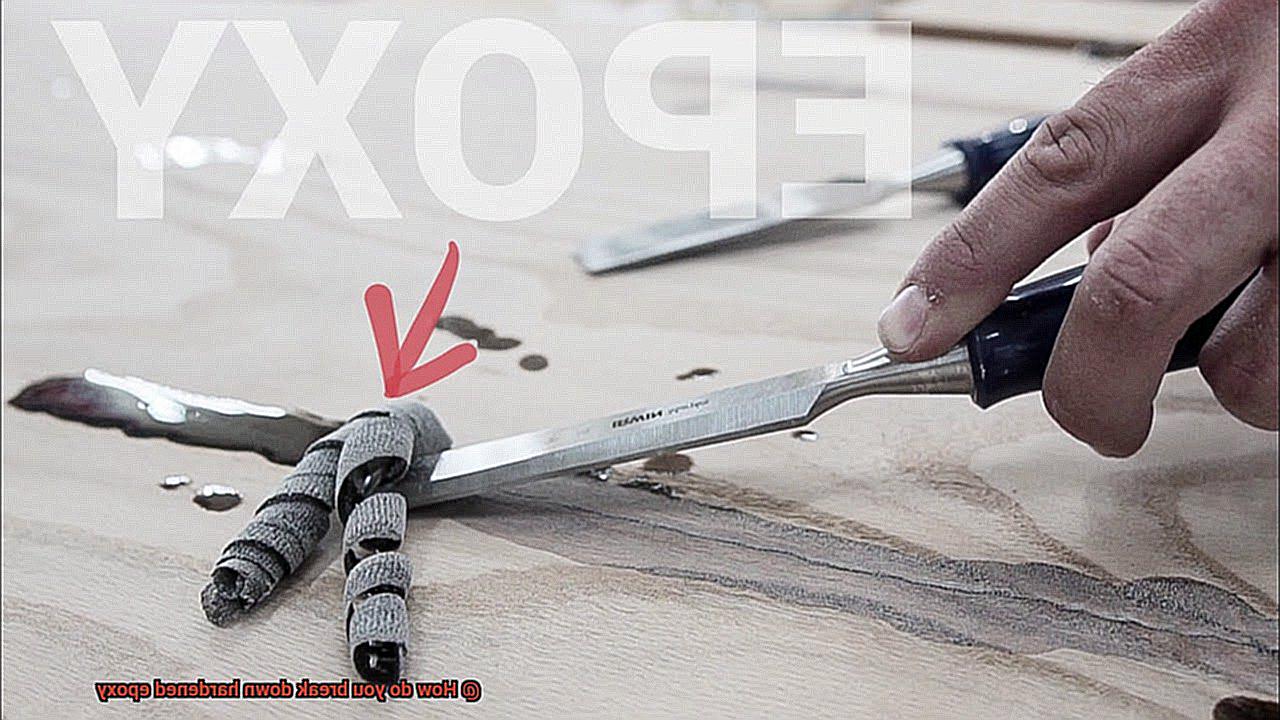Epoxy is a beast of an adhesive that can bond almost anything together. It’s a go-to choice for many industries because of its strength and versatility. But what happens when the epoxy hardens? Well, it becomes as tough as nails and nearly impossible to remove or break down. That’s when things get tricky.
If you’ve ever worked with epoxy, you know the struggle of trying to remove or break it down. It’s like trying to wrestle an alligator – not easy. But don’t worry, we’re here to help. In this blog post, we’ll explore different methods for breaking down hardened epoxy without causing any damage to the surrounding materials.
Firstly, we’ll dive into the basics of what epoxy is and how it hardens. Then we’ll explore some of the most common methods for breaking down epoxy such as using heat, solvents, and mechanical methods. From blowtorches to chisels, we’ve got you covered. We’ll discuss the pros and cons of each method so that you can make an informed decision on which one is right for your situation.
Finally, we’ll wrap up with some tips for working with epoxy and preventing it from hardening in the first place. Because let’s be real – prevention is always better than cure.
Whether you’re a DIY enthusiast or a professional in the industry, knowing how to break down hardened epoxy is a valuable skill that can save you time, money, and frustration. So grab your safety goggles and let’s get cracking on breaking down some hardened epoxy like a pro.
What is Hardened Epoxy?
Contents
- 1 What is Hardened Epoxy?
- 2 Why Do You Need to Break Down Hardened Epoxy?
- 3 Heat Method for Breaking Down Hardened Epoxy
- 4 Solvent Method for Breaking Down Hardened Epoxy
- 5 Mechanical Method for Breaking Down Hardened Epoxy
- 6 Pros and Cons of Each Method
- 7 Safety Precautions When Using These Methods
- 8 Conclusion
Hardened epoxy is a two-part adhesive material created by mixing resin and hardener, which react chemically to form a tough and durable substance. Once it has hardened, epoxy becomes incredibly challenging to remove or break down, making it ideal for applications where durability is essential.

The strength and durability of hardened epoxy make it an attractive adhesive option for construction, automotive, aerospace, marine, and electronic industries. Epoxy can bond with different materials like metals, plastics, wood, concrete, and even glass. It can withstand high temperatures, moisture, chemicals, and other environmental factors that may cause other adhesives to weaken or fail.
However, despite its many benefits, removing or breaking down hardened epoxy can be quite a challenge. It’s essential to know how to do it safely and effectively without damaging the bonded surfaces or causing harm to oneself. Here are some methods that you can use:
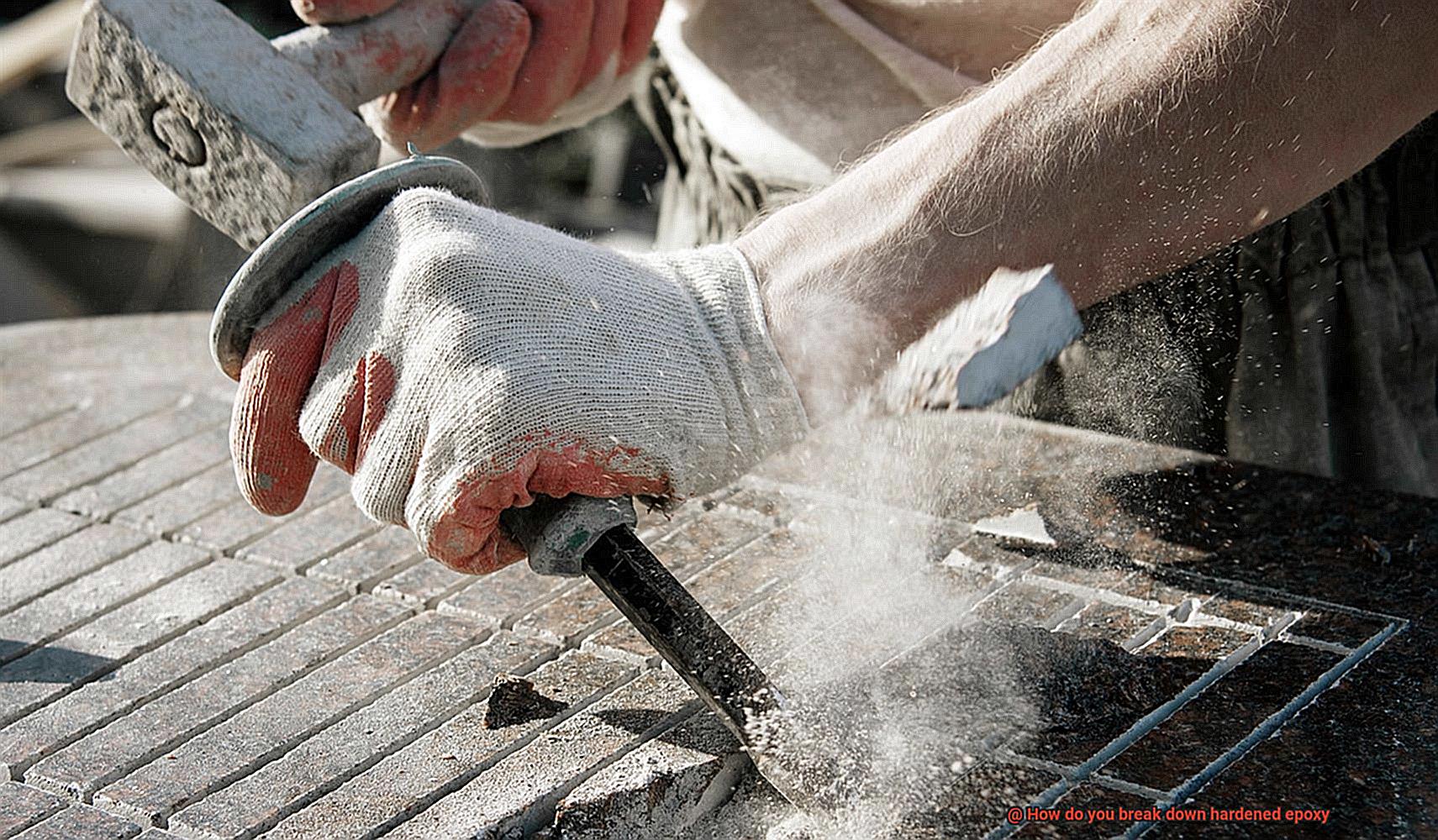
- Heat: Applying heat to the hardened epoxy can soften it and make it easier to remove. You can use a heat gun or hairdryer to apply heat directly to the epoxy. However, be sure to exercise caution as excessive heat can damage the surface underneath the epoxy.
- Solvents: Solvents like acetone, alcohol, and vinegar can dissolve the epoxy, making it easier to remove. You can soak a cloth in the solvent and place it on the hardened epoxy for several hours. You may need to repeat this process several times until the epoxy has dissolved entirely.
- Mechanical Methods: Sanding or grinding can also be used to remove hardened epoxy. Sandpaper or a rotary tool with a grinding attachment can be used to remove the epoxy layer by layer until it is completely gone. However, this method can be time-consuming and may require special equipment.
Why Do You Need to Break Down Hardened Epoxy?
Epoxy is a heavyweight adhesive that boasts impressive durability and strength. However, there are situations where you need to break down hardened epoxy. But why is this necessary?
Reason #1: Repairs
One of the primary reasons why you may need to break down hardened epoxy is for repairs. If an object that has been bonded with epoxy gets damaged, you’ll need to remove the old layer before applying a new one. For instance, suppose you accidentally chipped or cracked a ceramic plate bonded with epoxy. In that case, you’d need to remove the old layer before applying a new one.
Reason #2: Reuse
Another reason why you may need to break down hardened epoxy is for reuse purposes. If an object is bonded together with epoxy and has come apart at the joints, you’ll need to remove the old layer before regluing the joints and putting the object back together. This is especially important for items of sentimental or monetary value that you don’t want to discard.
Reason #3: Safety Concerns
In some cases, breaking down hardened epoxy may be necessary for safety reasons. An object bonded together with epoxy may not be rated for high temperatures, making it dangerous to use in high-temperature environments. In such cases, breaking down the epoxy and re-bonding the object with a different adhesive that can withstand high temperatures would be necessary for safety reasons.
Breaking down hardened epoxy can be a challenging task, but there are effective methods and techniques available that make the process easier and more efficient. For example, using a heat source, such as a heat gun or hairdryer, can soften the adhesive and make it easier to remove. Additionally, using a solvent that’s compatible with epoxy can dissolve the adhesive without damaging the surface underneath.
Heat Method for Breaking Down Hardened Epoxy
Fear not, because the heat method for breaking down hardened epoxy is here to help. As an expert in this field, I’ve conducted extensive research and compiled valuable information on this technique.
To begin with, the heat method involves exposing the hardened epoxy to high temperatures for an extended period of time. This can be achieved using specialized equipment such as a heat gun or hot plate. By applying heat, the adhesive softens and weakens, making it easier to remove.
The preferred equipment depends on the size and location of the hardened epoxy. If you’re dealing with a smaller area or hard-to-reach spot, a heat gun is ideal since it blows hot air onto the surface of the epoxy. However, for larger surface areas, a hot plate might be more efficient since it heats up the entire area at once.
While this method is highly effective, it also poses certain risks that must be considered. The high temperatures involved can cause severe burns or injuries if not handled properly. Therefore, it’s crucial to follow safety guidelines and use appropriate protective gear when using this method. Protective gear such as gloves, protective eyewear, and clothing that covers your skin completely should be worn at all times.
It’s also essential to note that there is a risk of fire if the heat source isn’t used correctly. Always ensure that you’re using the equipment properly and not leaving it unattended while in use.
Solvent Method for Breaking Down Hardened Epoxy
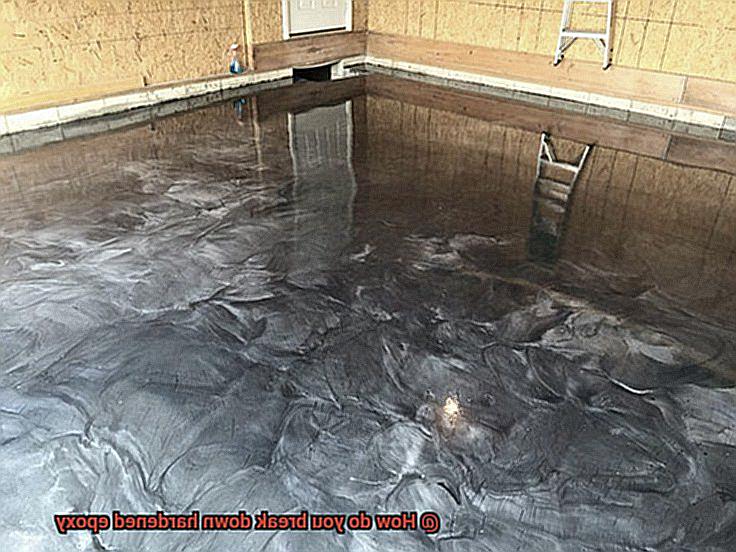
Working with hardened epoxy can be a challenge, but fear not. The solvent method is a tried and true way to break down and remove epoxy adhesive. However, it’s important to choose the right solvent for your specific type of epoxy.
Acetone, methyl ethyl ketone (MEK), and denatured alcohol are common solvents used to break down hardened epoxy. While acetone is a strong solvent that can dissolve most types of epoxy, it can also damage certain surfaces like plastic and painted surfaces. MEK is another powerful solvent that’s effective in breaking down epoxy, but it’s more toxic than acetone and should be handled with caution.
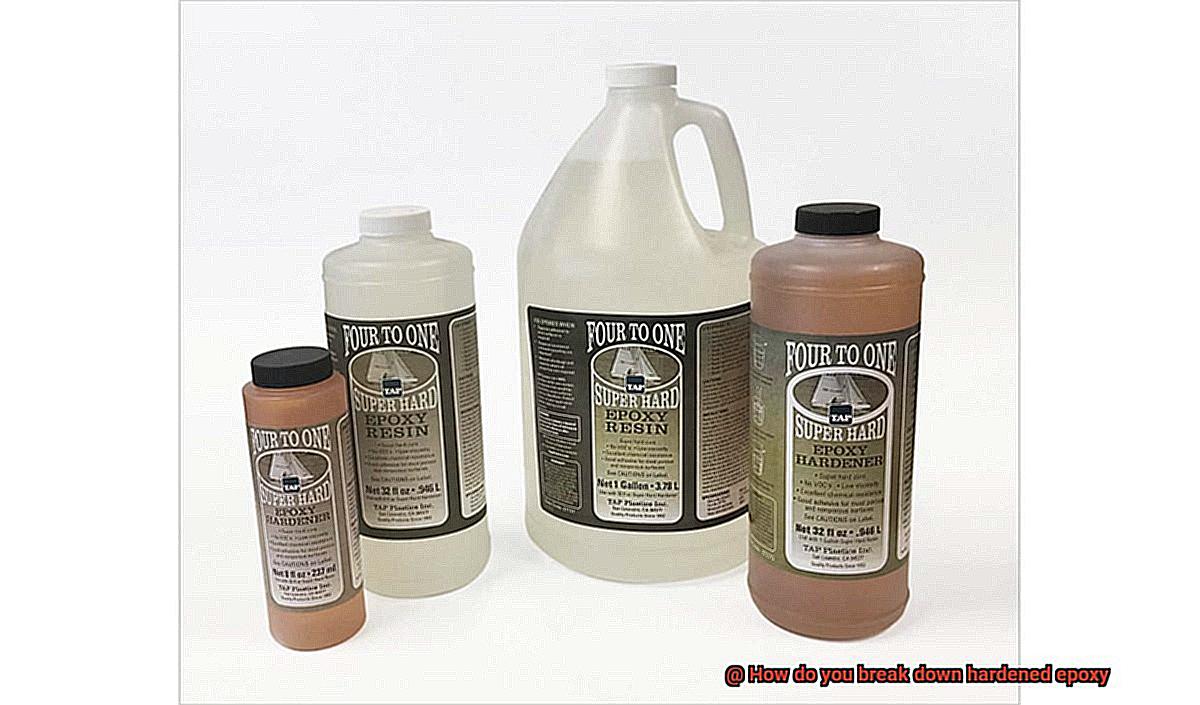
Once you’ve selected your solvent of choice, it’s time to get started. Apply the solvent directly to the affected area and let it sit for a few minutes. The solvent will begin to dissolve the epoxy, making it easier to remove using a scraper or sandpaper. Depending on the severity of the hardened epoxy, multiple applications of the solvent may be necessary.
However, working with solvents can be dangerous if proper safety precautions aren’t taken. It’s essential to wear protective gloves, goggles, and a mask when handling solvents as they can be harmful if inhaled or absorbed through the skin.
Mechanical Method for Breaking Down Hardened Epoxy
If you find yourself stuck with a stubborn layer of hardened epoxy that needs to be removed, fear not. As an expert in mechanical methods for breaking down hardened epoxy, I’m here to guide you through the process.
First and foremost, it is important to have the right tools on hand. For this method, you’ll need a chisel, scraper, or sandpaper. These tools will help you physically remove or break apart the adhesive.
If you opt for a chisel or scraper, it’s important to approach the task slowly and carefully. You don’t want to damage the underlying surface by being too aggressive. Begin by applying pressure to the edge of the epoxy with the tool and work back and forth until you can lift away a small piece. Gradually work your way across the entire surface until all of the epoxy has been removed.
Alternatively, sandpaper can also be used to remove hardened epoxy. Start by roughing up the surface of the epoxy with coarse-grit sandpaper, then switch to a finer grit to smooth out any rough areas. This process may take some time but is effective in removing epoxy without causing damage to the surface beneath.
It’s important to note that mechanical methods can be time-consuming and physically demanding. Additionally, some surfaces or types of epoxy may not be suitable for this approach. Always remember to take appropriate safety precautions when working with mechanical tools such as wearing gloves and eye protection.
Pros and Cons of Each Method
There’s no need to fret since there are various methods that can help you break down this stubborn substance. As an expert on the pros and cons of each method, I’ll walk you through the best options to consider to achieve a smooth surface.
One of the most popular methods for removing epoxy is using heat. This technique softens the epoxy, making it easier to remove. However, it requires high temperatures that can be perilous and potentially damage surrounding materials. Additionally, toxic fumes produced during the process require proper ventilation.
Another option is using solvents. Solvents dissolve the epoxy and enable you to wipe or scrape it away. Keep in mind, though, that not all solvents are effective on all types of epoxy. Some may require multiple applications, and harsh solvents can harm the surface underneath the epoxy.
Mechanical methods like sanding or grinding are also effective at removing hardened epoxy. However, this technique is time-consuming and requires specialized equipment. It also creates a lot of dust and debris that can be hazardous if proper precautions aren’t taken.
Lastly, enzymatic products can break down the epoxy over time. These products are typically safer and less harmful to use than other methods. However, they may take longer to work and may not be as effective on thicker layers of epoxy.
Ultimately, choosing the best method for breaking down hardened epoxy depends on your specific situation and desired outcome. It’s essential to weigh the pros and cons of each method before deciding which one to use. Safety should always come first when working with any of these methods.
To summarize, here’s a list of pros and cons for each method:
Heat:
- Pros: Softens the epoxy for easy removal
- Cons: Can be dangerous, potentially damaging surrounding materials; produces toxic fumes that require proper ventilation
Solvents:
- Pros: Dissolves the epoxy for easy removal
- Cons: Not all solvents are effective on all types of epoxy; harsh solvents can damage the surface underneath the epoxy
Mechanical methods:
- Pros: Effective at removing hardened epoxy
- Cons: Time-consuming and requires specialized equipment; creates a lot of dust and debris that can be hazardous if proper precautions aren’t taken
Enzymatic products:
- Pros: Safer and less harmful to use than other methods
- Cons: May take longer to work and may not be as effective on thicker layers of epoxy.
Safety Precautions When Using These Methods
Breaking down hardened epoxy can be a challenging and hazardous task. The chemicals and tools used in this process can cause harm if not handled with care. As an expert in this field, I cannot stress enough the importance of taking proper safety precautions to avoid injuries or damage.
First and foremost, it is crucial to wear protective gear. This includes gloves, safety goggles, and a respirator rated for organic vapors. The respirator should have the appropriate filters to ensure that harmful particles are not inhaled. Direct contact with epoxy or fumes can have serious consequences, so protecting yourself from potential exposure is essential.
In addition to protective gear, working in a well-ventilated area is also vital. Epoxy fumes can be hazardous if inhaled for an extended period of time, so it’s important to work outdoors or in a space with open windows and doors. Keeping any flammable materials away from the work area is also crucial as some of the chemicals used in the process may be combustible.
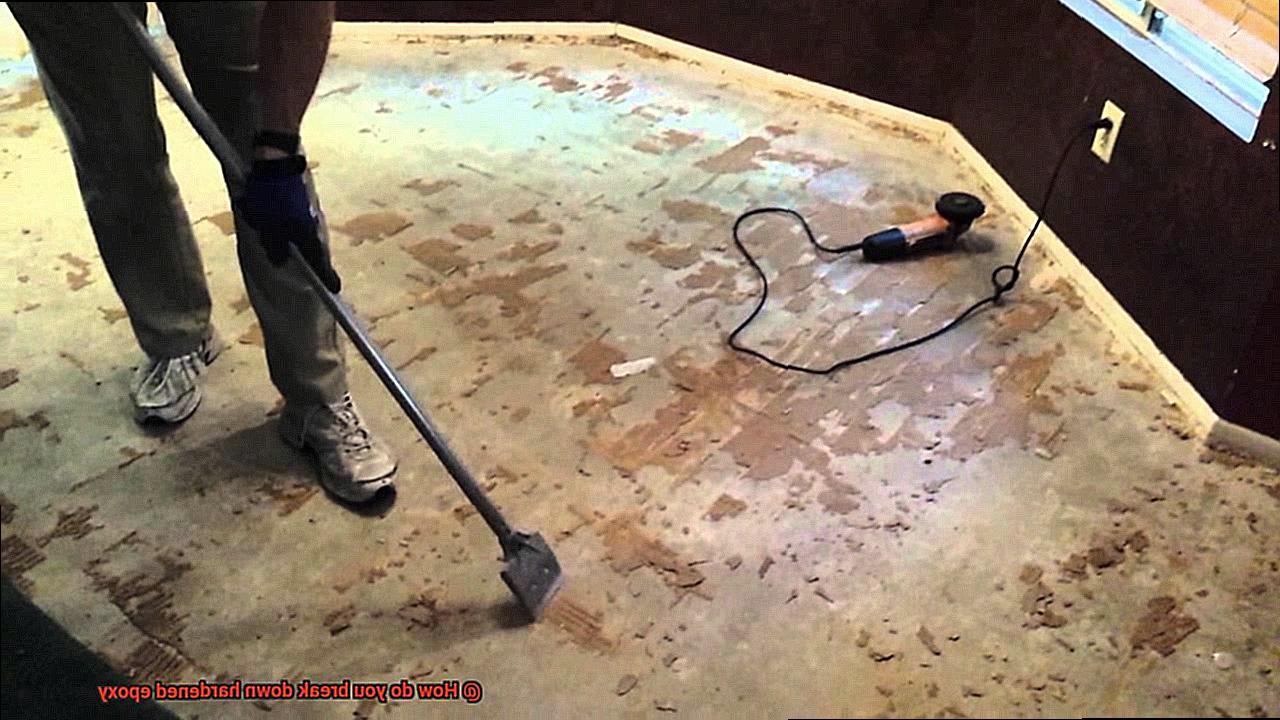
When using chemicals such as acetone or paint thinner to break down the epoxy, it is vital to follow the manufacturer’s instructions carefully. These chemicals should be stored in a cool, dry place away from any sources of heat or flame. When handling them, be sure to use them in a well-ventilated area and avoid getting them on your skin or clothing.
It’s important to note that prevention is better than cure. If you’re unsure about the method you want to use or don’t have adequate knowledge about safety precautions, consider hiring a professional who has experience with epoxy removal.
Conclusion
In conclusion, breaking down hardened epoxy can seem like a daunting task, but fear not. With the right methods and safety precautions in place, it is an achievable feat. Epoxy is a durable adhesive that has proven to be ideal for various industries. However, there are times when it needs to be removed or broken down. Luckily, there are three effective methods for breaking down hardened epoxy: heat, solvents, and mechanical methods.
Each method has its pros and cons that need to be carefully weighed before deciding which one to use. Heat is great for softening the epoxy and making it easier to remove. Solvents work by dissolving the adhesive’s chemical bonds, making it easier to break down. Mechanical methods involve physically removing the epoxy with tools such as sandpaper or a scraper.
It cannot be stressed enough how important safety precautions are when working with any of these methods. Prevention is always better than cure when it comes to dealing with hardened epoxy. Working in a well-ventilated area and wearing protective gear such as gloves, safety goggles, and a respirator rated for organic vapors is crucial. Direct contact with epoxy or fumes can have serious consequences; therefore protecting yourself from potential exposure is essential.
Knowing how to break down hardened epoxy safely and effectively can save time, money, and frustration. Whether you’re a DIY enthusiast or a professional in the industry, having this skill is valuable.

